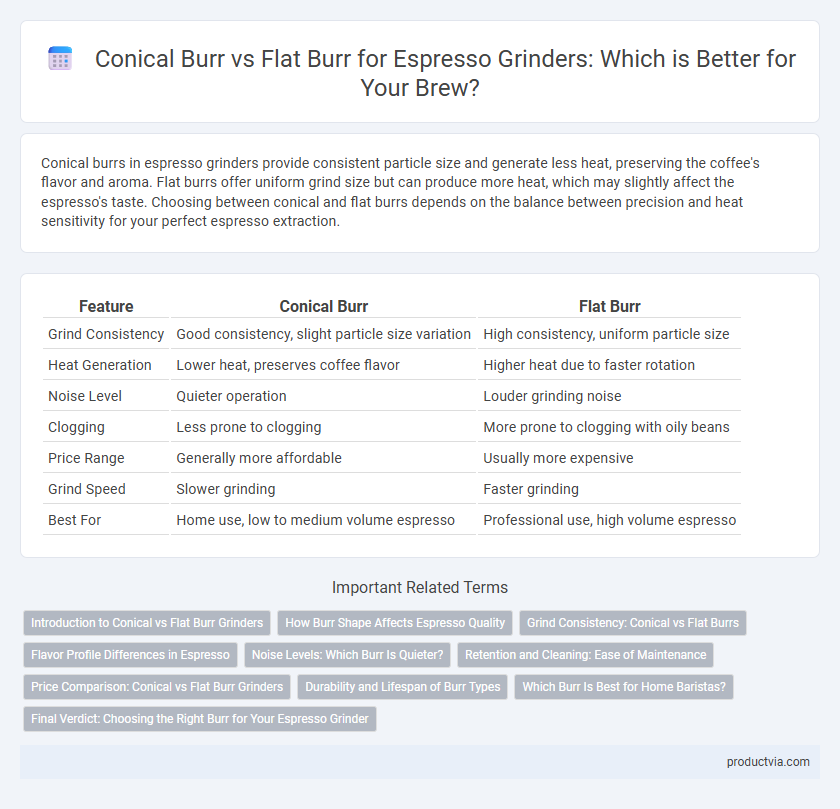Conical burrs in espresso grinders provide consistent particle size and generate less heat, preserving the coffee's flavor and aroma. Flat burrs offer uniform grind size but can produce more heat, which may slightly affect the espresso's taste. Choosing between conical and flat burrs depends on the balance between precision and heat sensitivity for your perfect espresso extraction.
Table of Comparison
| Feature | Conical Burr | Flat Burr |
|---|---|---|
| Grind Consistency | Good consistency, slight particle size variation | High consistency, uniform particle size |
| Heat Generation | Lower heat, preserves coffee flavor | Higher heat due to faster rotation |
| Noise Level | Quieter operation | Louder grinding noise |
| Clogging | Less prone to clogging | More prone to clogging with oily beans |
| Price Range | Generally more affordable | Usually more expensive |
| Grind Speed | Slower grinding | Faster grinding |
| Best For | Home use, low to medium volume espresso | Professional use, high volume espresso |
Introduction to Conical vs Flat Burr Grinders
Conical burr grinders feature two cone-shaped burrs that crush beans between a stationary outer burr and a rotating inner burr, resulting in consistent particle size and reduced heat generation. Flat burr grinders consist of two parallel, flat burr plates that grind beans evenly but produce slightly more heat, which can affect espresso flavor. Choosing between conical and flat burr grinders depends on preferences for grind consistency, flavor preservation, and noise levels.
How Burr Shape Affects Espresso Quality
Conical burrs produce a bimodal particle distribution that enhances espresso extraction by promoting even water flow and consistent crema, resulting in richer flavor complexity. Flat burrs create a more uniform particle size, which improves extraction precision and clarity but may risk channeling if not properly calibrated. The burr shape directly influences grind consistency, heat generation, and flavor profile, making it critical in achieving balanced espresso quality.
Grind Consistency: Conical vs Flat Burrs
Conical burr grinders produce a more uniform grind size due to their slower rotation speed and layered grinding mechanism, which reduces heat buildup and preserves coffee flavor. Flat burr grinders deliver precise particle size distribution by crushing beans between two parallel discs, resulting in a consistent espresso extraction. Overall, conical burrs excel in grind consistency for home use, while flat burrs are preferred in commercial settings for their rapid, uniform output.
Flavor Profile Differences in Espresso
Conical burr grinders produce a more varied particle size distribution, enhancing complex flavor notes and preserving aroma in espresso. Flat burr grinders create a more uniform grind, resulting in a cleaner, brighter taste with sharper acidity. The choice between conical and flat burrs significantly influences the espresso's body and flavor clarity, with conical burrs favoring richer, fuller profiles and flat burrs emphasizing crispness and balance.
Noise Levels: Which Burr Is Quieter?
Conical burr grinders generally produce less noise compared to flat burr grinders due to their slower rotational speed and more efficient grinding mechanism. Studies measuring decibel levels show conical burrs operating around 55-60 dB, while flat burr grinders often reach 65-70 dB during espresso grinding. Quieter operation makes conical burr grinders preferable for home environments where noise reduction is a priority.
Retention and Cleaning: Ease of Maintenance
Conical burr grinders tend to have lower retention due to their design, allowing coffee grounds to fall more freely during grinding, which reduces waste and flavor carryover. Flat burr grinders often retain more coffee grounds within the grinder mechanism, leading to increased retention that can affect espresso freshness. Cleaning conical burrs is generally easier since their shape and spacing allow for quicker removal of trapped grounds, while flat burrs require more meticulous disassembly and cleaning to prevent buildup and maintain optimal performance.
Price Comparison: Conical vs Flat Burr Grinders
Conical burr grinders typically cost less than flat burr grinders, making them a popular choice for espresso enthusiasts on a budget. Flat burr grinders often come with higher price tags due to their precision engineering and consistency in particle size distribution. Investing in a flat burr grinder can offer more uniform extraction, but conical burr grinders deliver excellent performance at a more accessible price point.
Durability and Lifespan of Burr Types
Conical burrs, typically made from hardened steel or ceramic, offer enhanced durability due to their slower rotation speed and reduced heat generation, which minimizes wear and maintains sharpness longer. Flat burrs, while providing consistent grind size, often experience faster wear because of higher RPMs and increased friction during grinding. Choosing conical burrs can extend the lifespan of your espresso grinder, ensuring consistent performance and reduced maintenance costs over time.
Which Burr Is Best for Home Baristas?
Conical burr grinders provide consistent particle size and generate less heat, preserving coffee aroma, making them ideal for home baristas seeking precision and flavor. Flat burr grinders deliver uniform grind size and better extraction control but tend to heat up faster, which can impact taste during prolonged grinding sessions. For home use, conical burrs offer a more forgiving grind with less noise and maintenance, making them the preferred choice for espresso enthusiasts.
Final Verdict: Choosing the Right Burr for Your Espresso Grinder
Conical burr grinders offer consistent particle size and efficient heat dissipation, making them ideal for preserving espresso flavor and aroma. Flat burr grinders provide uniform grind size distribution, which enhances extraction precision and produces a cleaner, more balanced shot. Choosing the right burr depends on your preference for flavor clarity versus body richness and your grinder's heat management capabilities.
Conical burr vs Flat burr for espresso grinders Infographic

 productvia.com
productvia.com